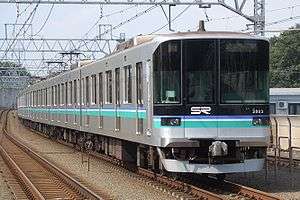Saitama Rapid Railway 2000 series
| Saitama Rapid Railway 2000 series | |
|---|---|
|
A Saitama Rapid 2000 series on the Tokyu Meguro Line, September 2005 | |
| In service | March 2001 – present |
| Number built | 60 cars (10 sets) |
| Number in service | 60 cars (10 sets) |
| Formation | 6 cars per trainset |
| Operator(s) | Saitama Railway Corporation |
| Depot(s) | Urawa-Misono |
| Line(s) served | Saitama Rapid Railway Line, Tokyo Metro Namboku Line, Tokyu Meguro Line |
| Specifications | |
| Car body construction | Aluminium |
| Car length | 20,000 mm (65 ft 7 in) |
| Width | 2,780 mm (9 ft 1 in) |
| Doors | 4 pairs per side |
| Maximum speed | 110 km/h (70 mph) |
| Electric system(s) | 1,500 V DC |
| Current collection method | Overhead catenary |
| Track gauge | 1,067 mm (3 ft 6 in) |
The Saitama Railway 2000 series (埼玉高速鉄道2000系) is an electric multiple unit (EMU) train type operated on the Saitama Rapid Railway Line in Saitama Prefecture, Japan, by the third-sector railway operating company Saitama Railway Corporation since March 2001.
Operations
The trains are used on Saitama Rapid Railway Line services, with through-running to and from the Tokyo Metro Namboku Line and Tokyu Meguro Line.[1]
Formations
As of 1 April 2014, the fleet consists of 10 six-car sets, each formed of three motored ("M") cars and three non-powered trailer ("T") cars, as shown below, with car 1 at the northern (Urawa-Misono) end.[1]
| Car No. | 1 | 2 | 3 | 4 | 5 | 6 |
|---|---|---|---|---|---|---|
| Designation | CT1 | M1-1 | Tc2 | M1-3 | M1-4 | CT2 |
| Numbering | 2100 | 2200 | 2500 | 2600 | 2700 | 2800 |
- Car 2 has a lozenge-type pantograph, and car 4 has two.[1]
- Cars 2 and 5 each have a wheelchair space.[1]
- Car 4 is designated as a mildy air-conditioned car.[1]
Interior
Passenger accommodation consists of longitudinal bench seating with priority seats in each car.[1]
 Interior view
Interior view Priority seating (right) at end of car
Priority seating (right) at end of car
History
The 2000 series trains entered service on 28 March 2001, coinciding with the opening of the Saitama Rapid Railway Line.[1]
References
| Wikimedia Commons has media related to Saitama Railway 2000 series. |
